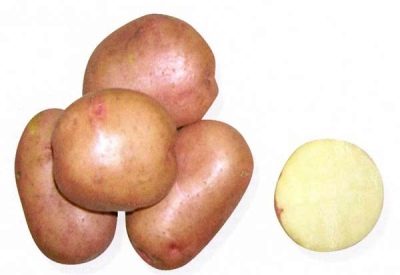
- Authors: Dorozhkin Boris Nikolaevich, Dergacheva Nadezhda Viktorovna, Sogulyak Sergey Vladimirovich, Cheremisin Alexander Ivanovich, Petryakova Olga Vasilievna, Kuzmina Svetlana Gennadievna (State Scientific Institution Siberian Research Institute of Agriculture)
- Year of approval: 2009
- Appointment: table, suitable for making French fries, chips
- Tuber weight, g: 101-179
- Peel color: red
- Color of the pulp: cream
- Starch content,%: 17,0-21,8%
- Tuber shape: oval-rounded
- Peel structure: smooth
- Flowers: anthocyanin color of the bud is weak, light red-violet
The Hostess potato is a relatively young variety, but it has already gained great popularity among gardeners. In care, the variety does not cause any particular problems. However, subject to agrotechnical rules, the culture will delight you with a large harvest of truly tasty fruits.
Description of the variety
The Khozyayushka variety was created on the basis of the Siberian Research Institute of Agriculture in 2009 by crossing species such as Santa and Zarevo. Scientists have sought to create a plant that can grow in any climatic conditions, which they have succeeded. The culture tolerates temperature fluctuations well and is undemanding to the composition of the soil.
The pluses of the variety include:
- unpretentious care;
- excellent taste;
- long-term storage of root crops with a minimum amount of losses;
- relative drought resistance;
- high productivity.
Among the disadvantages are the following:
- root vegetables may crack;
- slight resistance to late blight of leaves.
Characteristics of the appearance of the bush and root crops
The plant grows tall, about 50 cm. The stems are semi-erect, with few leaves, of an intermediate type. The leaves are large, with strong waviness at the edges, dark green in color. Potatoes bloom with compact and small light red-purple inflorescences.
On average, under one bush, from 8 to 14 tubers are formed, with a weight of 101-179 g. Their shape is oval-round, tubers are obtained with a smooth and thin skin of red color. There are some small eyes on the surface. The pulp is creamy, does not darken when cut. High keeping quality (95%) and marketability (87-97%).
Purpose and taste of tubers
The taste is excellent. The hostess belongs to the table varieties of group C. Due to the high starch content in the composition (17-21.8%), tubers are ideal for making mashed potatoes, soups, side dishes, French fries, chips. When boiling, the roots are well boiled. But the variety is not suitable for frying.
Maturation
Mid-season variety. It takes 100-110 days for the tubers to fully ripen.
Yield
Potatoes are very productive: usually 178-355 centners can be harvested from 1 hectare of soil. The maximum indicators are 383 c / ha.
Growing regions
The variety can be cultivated in almost all regions of the country. However, the most favorable areas for culture, where it shows the maximum yield indicators, are the West Siberian and East Siberian regions.
Growing and care
Before planting potatoes on the site, they are prepared. To do this, carefully selected tubers without signs of damage and disease are left in a bright place for 20-30 days at a temperature of + 12-15 degrees. On the day of planting, root crops are treated with a disinfectant solution. It can be a weak solution of potassium permanganate or copper sulfate.
You should not rush to land.We need to wait until warm weather sets in and the earth warms up for a comfortable +8 degrees. The optimal time for planting is early or mid-May.
Despite the fact that the variety can be grown throughout Russia, it is not particularly recommended to plant a crop in regions with too harsh climates. Since potatoes are a thermophilic plant, in these areas you may not have time with planting, which is strictly prohibited to tighten.
Of particular importance in the planting of the Hostess is the scheme: since the plant grows tall, the bushes should not thicken each other. The distance between the rows is 50-60 cm, between the holes - 35-40 cm.The maximum depth of the hole is no more than 10 cm.
The culture is easy to care for. Irrigation should be carried out systematically, preventing the soil from drying out, but it should not be brought to excessive moisture either. They also provide the variety with additional nutrition, which can significantly increase yields. Top dressing is applied 3 times per season. The first is given in the spring, fed with mineral fertilizers. The other two are introduced during the formation of inflorescences and after the end of flowering. They use organics here.
A tall variety is spud 3 times per season. The first event is carried out when the shoots reach a height of 20 cm, the second is done after 2 weeks, the third - after another 3 weeks. Weeding of beds from weeds is carried out as needed.

Planting potatoes is one of the main spring activities traditional for Russian gardeners. There are many ways to plant this vegetable, allowing you to get a good harvest in different conditions and climates. Before planting, you need to carefully prepare the planting material, correctly determine the timing, competently prepare the soil.


Soil requirements
As experienced vegetable growers note, the best yield indicators are observed when growing crops on sandy or loamy soils with additional enrichment with compost or rotted manure.

Disease and pest resistance
As the manufacturer notes, the variety is affected by fungal infections, especially late blight and macrosporiosis. Copper-based drugs cope well with diseases. Among pests, the Colorado potato beetle, aphids, moths and thrips are especially dangerous, with the appearance of which plants are treated with insecticides.

Potatoes are a popular vegetable crop that many gardeners planted on their site. But growing a bountiful harvest of tasty and large tubers is unlikely to succeed if the beds are not properly protected from the most common diseases and pests. Often, the development of diseases of various etiologies of potatoes goes unnoticed, so it is important to identify the problem in time and eliminate it.
















































































